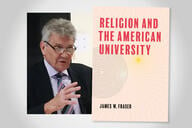You have /5 articles left.
Sign up for a free account or log in.

Getty Images
I'm a teacher from a family of teachers. My father, who was a school principal, used to talk about hiring good teachers. He believed that some teachers have an instinct for it while others, less so. I believe that too. I have seen it.
But what does it mean to have an “instinct” for teaching? Or an instinct for anything, for that matter? I have no instinct for visual arts, and yet I have learned to take photographs that I am proud to hang on my wall. I will never be as good as my wife, who is visually talented and went to art school, but I have learned to be better than I was and good enough for my own needs. Teaching requires the belief in this possibility: that people who don’t have “the instinct” can nevertheless be taught and thus improve. And also that people who do have talent can be taught to make the most of it, becoming better than they would have been without the help of their education.
And yet, even as we help students learn to see, grasp, and manipulate the building blocks of our respective disciplines every day in the classroom, many of us cling to the belief that what we do as teachers is somehow different. Sometimes we think of it is as trivially straightforward. Other times we think of it as ineffable art. In either case, it is outside the realm of that which can be studied. There is very little sense among the professoriate that teaching is a discipline that advances and of which, as practitioners, they should also be scholars.
Partly funded by a grant from the Bill & Melinda Gates Foundation, I recently had the pleasure of interviewing several professors affiliated with Carnegie Mellon University’s Simon Initiative who all study aspects of “learning science” even though they are trained in different academic disciplines. They are also practitioners -- teachers. Here is some of what they had to say about applying science to teaching:
If you have ever taught for any significant period of time and reflected on that experience even a little, you will probably remember moments of failure like those described by Herckis and Koedinger. Maybe you have adjusted your teaching in response to that failure so that you could make the lesson go better the next time. Teaching is empirical.
But as a profession, we have not been systematically empirical. There is a term for a frequent cause of the problem that Koedinger describes of being frequently wrong about what his students will find to be difficult: expert blindness.
Experts think differently from non-experts and are often unconscious of how their thought processes changed as they became experts. Yet we are not working together to identify those areas where expert blindness might be a problem that needs to be addressed in the teaching of our various disciplines.
Likewise, the kind of gulf that Herckis describes between knowing what to do in theory and actually being able to do it effectively in practice has been studied in other fields such as public health. Yet it is often unrecognized, let alone planned for, as an obstacle to large-scale improvement within conversations about improving educational outcomes. There are just two of many examples where we fail to apply academic rigor to the study of one of the core functions of the academy.
We are at the dawn of a science of the mind that is analogous to the dawn of modern medicine in the 19th and early 20th centuries. We are just barely beginning to learn how the mind works. This field will only truly advance once the majority of learning science practitioners -- classroom educators -- embrace their role as experts in the field of applied learning science, committed to both learning the latest advances and mindfully engaging in scientific method as a core part of their teaching practice.
Right now, when we hear about learning science at all, it is usually in the context of a product pitch. We are told we should trust this software will work “thanks to the science of neuroplasticity.” We hear about products that “take the combined data power of millions of students” to recommend the perfect content for each student. Most college instructors have no way to make sense of these claims, much less evaluate them. It’s as if the pharmaceutical industry is being invented in absence of a medical profession.
If we are going to meet the educational challenges of this century, then we must bring applied learning science to every classroom. This will require massive change on every level, from the training of graduate students to tenure and promotion, from the role and support of contingent labor to the professional identity and ego investment of many faculty members. It is a transformation that will take decades to complete. But it all starts with a simple commitment:
We should no longer consider teaching by instinct to be “good enough,” however good one’s teaching instincts may be. We should all be working together to understand the basis for those instincts, make the knowledge that informs them explicit, and improve upon our shared knowledge of how teaching and learning work.
We should recognize the disciplinarity of teaching and scientific study of learning. And we should embrace the notion that, if you teach as part of your job, then you must in some sense become a student of that discipline and a participant in that scientific endeavor.
There are many ways to start this journey if you have not already embarked upon it. You can go to your campus’s Center for Teaching and Learning. You can talk to a colleague about a challenge you have teaching a concept in one of your classes. Read up on a teaching technique that interests you. Browse a journal. Go to a conference.
There is no single best way for everyone, other than to generally become curious about your classroom failures and unafraid to talk about them. Science requires hypotheses, which are guesses that must be tested and can be wrong.
If you are truly engaging in science, then you are testing enough hypotheses to be wrong about your guesses some of the time. You can choose to see those as your failures as a teacher, or perhaps as the failures of your students.
But you can also choose to see them as a necessary part of your work as an applied scientist and educator/clinician -- one in a cohort of many colleagues who are also learning, and who can learn from each other.




